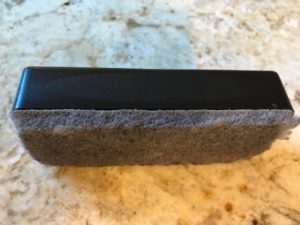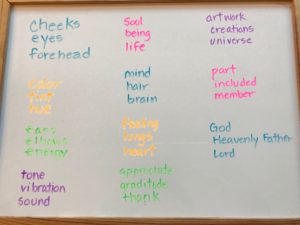Eraser Pass
 List these words up on the board
List these words up on the board

cheeks, eyes, forehead
color, tint, hue
ears, elbows, energy
tone, vibration, sound
soul, being, life
mind, hair, brain
feeling, lungs, heart
appreciate, gratitude, thank
artwork, creations, universe
part, included, member
God, Heavenly Father, Lord
The Rules
Tell the children that there are three rules to this game:
- Erase the words that are NOT in the song
- Pass the eraser to someone who has not had a turn. They will erase one word that is not in the song.
- No talking
Tell the children you will be singing the song through 7 times. Their job is to erase the words that are not in the song one by one while you are singing before you get through the song 7 times.
The Game
Hand the eraser to the first child with the instructions to erase one word that is not in the song. Sing the 3rd verse of the song. Encourage the child to erase, then give the eraser to someone else in the room.
Continue singing the song again and again, and having the children pass the eraser until only the words that are in this verse are on the board. (If a child accidentally erases a word that is in the song, just have a whiteboard marker or chalk handy to fill it back in and continue singing.)
Challenge the children to sing the song with you, BUT only sing the words that are on the song. Tell them you will be singing all of the other words.
Now switch! They sing all the other words and you sing only the words on the board.
The Benefits
Because the words are often synonyms, seeing these words to decipher which one is in the song adds to the children’s understanding of the song.
Because the children are engaged in the “puzzle” as they hear the song, the words slip into the back door of the minds in a pattern.
Because they have to sing only some of the words, they hear the other words with their “inside voice,” one of the strongest ways to learn.

Tricia Craft
Thanks for a great idea!
DeAnna
Never done this, but trying this method out this year.
Kristina Chamberlain
We love doing Eraser Pass. Can I offer a suggestion from my own experience? When I start the eraser at the back of the room (where the oldest children sit), we have a more successful activity. Starting the eraser at the front with the new CTR 8 class always ends in a lot of blank stares, especially at the beginning of the year when they haven’t seen this game before. By starting the eraser at the back of the room, the older kids have the challenge of finding the right words when the greatest number of options are on the board. By the time the eraser reaches the front of the room, only a few wrong words are still on the board, and the younger kids have seen many examples of what to do, so they have a better time. Hope this is helpful!
And thank you, Sister Dance, for another wonderful activity!
Sharla Dance
Thank you Kristina!! Yes, by all means start with a older children. You are so wise!
Annie
That is an incredible idea! That has been my exact challenge with this activity!
Cynthia Goates
I love this activity! And yes, definitely start eraser with the older kids. By the time it gets to the younger ones, they have figured out the game and can see which words should be left. We just pass it along the row.
I’m going to use this game tomorrow for “In That Holy Place” by Sally DeFord. This will help cement the words for them.
Donna
How can they sing all the other words in the song when you switch if they have all been erased?
Sharla Dance
Dear Donna,
All of the words that were erased were NOT in the song. The words left on the board are only SOME of the words of the song. When the sing only the words on the board and you sing the other words, you are singing the other words in the song that are not listed on the board, but are still in the song. They then switch to sing words that are not listed on the board, but are still in the song you are singing.
Donna
Thank you Sharla. I was thinking you meant they were to sing the erased words and that made no sense to me. lol
Anjeanette
We have such a small primary that we do singing time with all age groups. This creates quite a frustrating learning experience for everyone. Any advice as to how to keep everyone involved in this situation?
Sharla Dance
You literally have to have two different systems: 1. The buddy system where an older child pairs with a younger child helping them do an activity (usually movement) that is a bit above the younger child’s developmental age, or 2. The younger children do an age appropriate activity while the older children are given a challenge that is appropriate for their age. You’ll need a helper to run both of the related, but very different activities.
Carrie
Anjeanette, we have the same issue. How I approached it was adding the rule that when an older child chose a (non-reading) younger child, they needed to accompany them back up to the board, help them climb onto the chair I’d placed next to the board, and point to the word they should erase and let them erase it. They loved it and everyone felt included.
Lynn
Just to share another way of managing the eraser….I tap the children on the shoulder for their turn to erase. The eraser stays up at the board and when a child is tapped, they go up and erase. That way I control who gets it when. I think Sharla has used this way also in a past song because I am sure I got it from her. Ha ha!
Dalyn Fitzgerald
Would you erase the words in order of the song? Do you stop singing while a child goes to the board to erase?
Sharla Dance
I continue singing while children go one by one to the board and erase one word that is not in the song. They can erase a word from the back, the middle, or the front of the song as long as the word is not in the song. Occasionally I will emphasize a word to help a child, but I don’t stop singing. After 7 or 8 children have erased words, I pause in the singing and ask the children if they can see other words on the board that are not in the song. I then continue right on singing the song again and again. This allows the children to hear the words in the pattern of the song with the melody and rhythm over and over, yet while they are still engaged in the “puzzle” of what is left to erase from the board.
Chanin Mauery
My kids loved this today!! Thanks for being such a valuable resource. We just recently divided into Jr. and Sr. sharing/singintime and it has been nice to have ideas that work for both age groups. Thanks so much!
Dalyn Fitzgerald
Do you continue singing while erasing the word or stop at the word?
Sharla Dance
I continue singing, but I will emphasize different words to give hints to the children if they look confused. They don’t have to erase the words that are not in the song in order. They can erase a word from the end or the middle or the first, then pass the eraser to another child. Thanks for asking.
Julie Thomson
This activity was so fun and effective. Thanks for sharing it.
Melanie Poole
It has been so fun to find your Facebook page and incorporate the fun new ways to approach learning the songs! In the saying you can’t teach a dog new tricks…Luckily I am not a dog!!
Jan
I used this activity this past Sunday and it was a success. I followed Kristina Chamberlain’s idea of starting the eraser in the back. By the time I had got through the song the 7 times most of the children were singing with me!
Marianne Reed
How does this work for Junior Primary?
Sharla Dance
I don’t use eraser pass for the younger primary. Instead I will use another movement that fits the feel of the song (sometimes just moving or sometimes with wind wands or paper plates or another extender of the movement), a 3 piece puzzle activity to put together while I sing, or pictures to put in order as I sing.
Thanks for asking!
Yolanda
It sounds like you use this method to introduce the song. When do you teach the meaning of the song? That same week or the following week?
Thanks!
Sharla Dance
Dear Yolanda. I use a 5 to 7 minute activity with the song every week for three or four weeks. All of the activities emphasize something different: words, rhythmic movement to the song, visual puzzles like concentration picture match up, or story song. With each of these activities, I bear a one sentence testimony about something in the song. With all of these four or so activities, the children little by little, line upon line begin to understand deeply the meaning of the song in their own way. It is better to have four different activities on four different weeks both for their improved remembering and for their increased understanding (I can tell the brain research about that if you’d like.)
Thanks for asking.